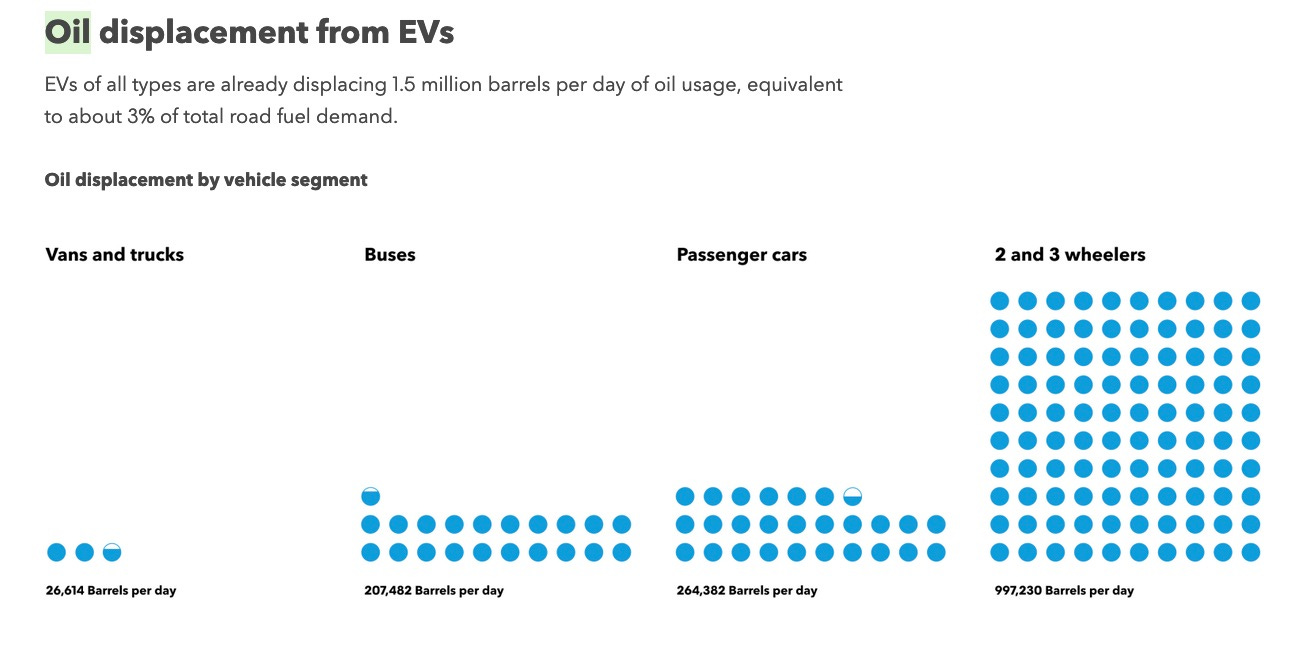Micromobility: An Urban Transportation Revolution
E-bikes, E-motorcycles, E-scooters displacing oil use and improving urban living
Annual sales of gas-powered vehicles peaked globally in 2017 and are now down 23% from the peak. In 2023 EVs represented 20% of global auto sales and 35% of sales in China. Today, there are 20 million EVs on the road worldwide.
The truly important news regarding transporation is the nearly 300 million electric two- and three-wheelers in use today.
Two and three-wheeled electric vehicles—bikes, scooters, skateboards, mopeds, motorcycles, trikes, auto-rickshaws—along with shared electric vehicles for personal transport—represent a global urban-transportation revolution known as micromobility.
Need-to-Know: Nearly 320 million electric vehicles in use today
These smaller electric vehicles displaced four times more oil demand than electric cars have. Of the 1.5 million barrels a day being displaced by all forms of electric transport, 65% of this displacement comes from two- and three-wheelers, according to BloombergNEF (BNEF).
Consider the micromobility context:
A fraction of the cost of an electric car or truck: $500 vs $50,000 or more.
Use a tiny fraction of valuable materials such as lithium.
Easily and cheaply recharged where ever there is a regular electrical outlet.
Around 60% of trips in cars are less than 10 kilometers in urban areas, a distance easily covered using some form of micromobility
Need-to-Know: Micromobility improves air quality and livability
Cities and urban areas are struggling with traffic congestion, soaring costs of public transit and road infrastructure, air pollution, carbon emissions, and the impacts of climate change. Micromobility aligns with the goals of creating more sustainable and livable cities by providing clean, low-cost vehicles that can move twice as many people as cars do per city block.
Cars are parked roughly 95% of the time. There are eight parking spaces for every car in the U.S. Fewer cars would free up enormous amounts of valuable urban space for parks, gardens, play and walking areas and other amenties, making cities and towns more liveable.
Need-to-Know: Micromobility solves traffic congestion
Drivers are stuck in traffic between 100 to 110 hours a year in the U.S. on average, while in cities like London, Paris, Moscow, Cairo, Istanbul, and Mumbai, it can be up to 150 hours. The hidden costs of traffic congestion, air pollution, carbon emissions, and accidents are between two to three times more than the cost of fuel-per-kilometer of road travel.
These hidden costs amount to $13 trillion a year globally, according to a 2021 study.
Need-to-Know: Micromobility makes public transit better
Microbility also solves public transit’s “first/last mile problem”—the distance someone needs to travel from a transit stop to their destination, and vice versa—as it is ideal for short trips up to 10 kilometers. Although some e-bikes are used for commutes up to 50 kilometers a day.
Need-to-Know: Micromobility has a major role in the decarbonization of transportation
Surface transportation is the second largest source of global greenhouse-gas emissions, accounting for 23% of global emissions.
Electrification via batteries is the most efficient, cost-effective, and commercially available route to fully decarbonizing road transport, according to BNEF.
Micromobility is expected to grow from 300 million vehicles to two or three billion vehicles by 2050 based on the escalating need for clean, low-cost forms of mobility as urban populations boom.
A few more data points about the growing popularity of micromobility.
By 2026, around 80% of rickshaws and other three-wheel vehicles in India will be electric.
At least half of the motorbike and motorcycles in Southeast Asia are expected to be electric versions by 2030.
80% of two-wheel vehicles in China are already electric, with 20 million vehicles sold annually.
4.5 million e-bikes were sold in Europe in 2022, twice the volume of electric cars sold. E-bikes now outsell traditional bikes in Germany, and by 2025, this will be the case in Europe as a whole.
Global oil demand from two and three-wheel vehicles has already peaked, playing a key role along with electric cars and electric light-duty vehicles in decarbonizing road transportation.
Until next time. Be well.
Stephen
P.S.
A reminder that you have until Monday Feb 5 to comment on Canada’s proposed cap on oil and gas production. Email your comments here: PlanPetrolieretGazier-OilandGasPlan@ec.gc.ca
See last week’s NtK for more: Canada’s Oil Sands Among the World's Biggest Sources of Air Pollution







